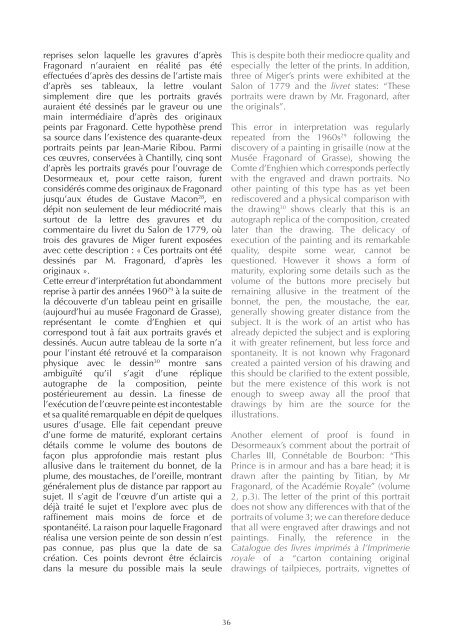You also want an ePaper? Increase the reach of your titles
YUMPU automatically turns print PDFs into web optimized ePapers that Google loves.
eprises selon laquelle les gravures d’après<br />
<strong>Fragonard</strong> n’auraient en réalité pas été<br />
effectuées d’après des dessins de l’artiste mais<br />
d’après ses tableaux, la lettre voulant<br />
simplement dire que les portraits gravés<br />
auraient été dessinés par le graveur ou une<br />
main intermédiaire d’après des originaux<br />
peints par <strong>Fragonard</strong>. Cette hypothèse prend<br />
sa source dans l’existence des quarante-deux<br />
portraits peints par Jean-Marie Ribou. Parmi<br />
ces œuvres, conservées à Chantilly, cinq sont<br />
d’après les portraits gravés pour l’ouvrage de<br />
Desormeaux et, pour cette raison, furent<br />
considérés comme des originaux de <strong>Fragonard</strong><br />
jusqu’aux études de Gustave Macon 28 , en<br />
dépit non seulement de leur médiocrité mais<br />
surtout de la lettre des gravures et du<br />
commentaire du livret du Salon de 1779, où<br />
trois des gravures de Miger furent exposées<br />
avec cette description : « Ces portraits ont été<br />
dessinés par M. <strong>Fragonard</strong>, d’après les<br />
originaux ».<br />
Cette erreur d’interprétation fut abondamment<br />
reprise à partir des années 1960 29 à la suite de<br />
la découverte d’un tableau peint en grisaille<br />
(aujourd’hui au musée <strong>Fragonard</strong> de Grasse),<br />
représentant le comte d’Enghien et qui<br />
correspond tout à fait aux portraits gravés et<br />
dessinés. Aucun autre tableau de la sorte n’a<br />
pour l’instant été retrouvé et la comparaison<br />
physique avec le dessin 30 montre sans<br />
ambiguïté qu’il s’agit d’une réplique<br />
autographe de la composition, peinte<br />
postérieurement au dessin. La finesse de<br />
l’exécution de l’œuvre peinte est incontestable<br />
et sa qualité remarquable en dépit de quelques<br />
usures d’usage. Elle fait cependant preuve<br />
d’une forme de maturité, explorant certains<br />
détails comme le volume des boutons de<br />
façon plus approfondie mais restant plus<br />
allusive dans le traitement du bonnet, de la<br />
plume, des moustaches, de l’oreille, montrant<br />
généralement plus de distance par rapport au<br />
sujet. Il s’agit de l’œuvre d’un artiste qui a<br />
déjà traité le sujet et l’explore avec plus de<br />
raffinement mais moins de force et de<br />
spontanéité. La raison pour laquelle <strong>Fragonard</strong><br />
réalisa une version peinte de son dessin n’est<br />
pas connue, pas plus que la date de sa<br />
création. Ces points devront être éclaircis<br />
dans la mesure du possible mais la seule<br />
This is despite both their mediocre quality and<br />
especially the letter of the prints. In addition,<br />
three of Miger’s prints were exhibited at the<br />
Salon of 1779 and the livret states: “These<br />
portraits were drawn by Mr. <strong>Fragonard</strong>, after<br />
the originals”.<br />
This error in interpretation was regularly<br />
repeated from the 1960s 29 following the<br />
discovery of a painting in grisaille (now at the<br />
Musée <strong>Fragonard</strong> of Grasse), showing the<br />
Comte d’Enghien which corresponds perfectly<br />
with the engraved and drawn portraits. No<br />
other painting of this type has as yet been<br />
rediscovered and a physical comparison with<br />
the drawing 30 shows clearly that this is an<br />
autograph replica of the composition, created<br />
later than the drawing. The delicacy of<br />
execution of the painting and its remarkable<br />
quality, despite some wear, cannot be<br />
questioned. However it shows a form of<br />
maturity, exploring some details such as the<br />
volume of the buttons more precisely but<br />
remaining allusive in the treatment of the<br />
bonnet, the pen, the moustache, the ear,<br />
generally showing greater distance from the<br />
subject. It is the work of an artist who has<br />
already depicted the subject and is exploring<br />
it with greater refinement, but less force and<br />
spontaneity. It is not known why <strong>Fragonard</strong><br />
created a painted version of his drawing and<br />
this should be clarified to the extent possible,<br />
but the mere existence of this work is not<br />
enough to sweep away all the proof that<br />
drawings by him are the source for the<br />
illustrations.<br />
Another element of proof is found in<br />
Desormeaux’s comment about the portrait of<br />
Charles III, Connétable de Bourbon: “This<br />
Prince is in armour and has a bare head; it is<br />
drawn after the painting by Titian, by Mr<br />
<strong>Fragonard</strong>, of the Académie Royale” (volume<br />
2, p.3). The letter of the print of this portrait<br />
does not show any differences with that of the<br />
portraits of volume 3; we can therefore deduce<br />
that all were engraved after drawings and not<br />
paintings. Finally, the reference in the<br />
Catalogue des livres imprimés à l’Imprimerie<br />
royale of a “carton containing original<br />
drawings of tailpieces, portraits, vignettes of<br />
36















